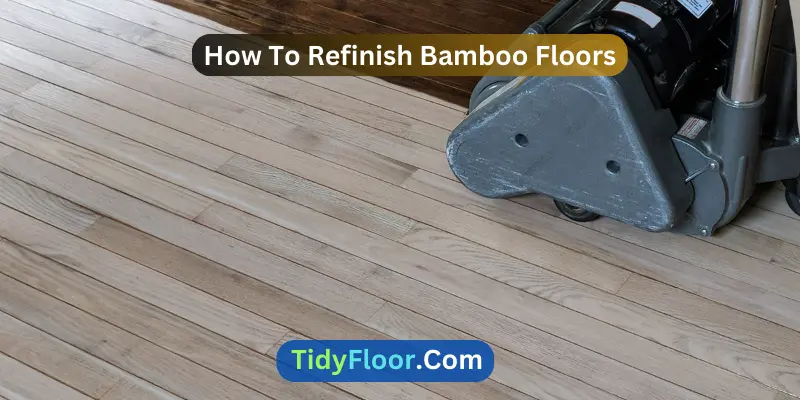Bamboo floors are not only visually appealing but also eco-friendly and durable. Over time, however, even the sturdiest of bamboo floors can show signs of wear and tear. Refinishing your bamboo floors can breathe new life into them, restoring their natural beauty. Whether you’re a seasoned DIY enthusiast or a first-timer, you must learn how to refinish bamboo floors to keep the floor shiny and long-lasting.
Refinishing bamboo floors involves gathering materials, preparing the room, sanding to remove the old finish, smoothing the surface, optional staining, applying water-based finish in thin coats, and optionally buffing for a smooth shine.
In this guide, we’ll take you through a step-by-step process to help you achieve a professional-looking finish for your bamboo floors. Keep reading to explore the techniques of bamboo floor refinishing.
Before you start the process, gather the materials listed below needed to refinish bamboo flooring:
- Paint tray and applicator
- Soft cloths or rags
- Polyurethane or varnish (water-based is recommended)
- Painter’s tape
- Plastic sheeting to protect walls and furniture
- Safety goggles and a dust mask
- Broom and vacuum cleaner
- Sandpaper (grit levels: 60, 120, and 220)
- Orbital sander
- Stain or finish of your choice
- Floor buffer (optional)
Time: 2 To 5 Days
Cost: Dollars 120 To 240
How To Refinish Bamboo Floors in 6 Step-by-Step Process: Detailed Guide
Refinishing bamboo floors is quite a common DIY project that people do to take care of their bamboo flooring. If you are skeptical about the process, no worries! I am here to explain to you the process of bamboo floor refinishing.
Step 1: Prepare the Room
Clear the room of all furniture and decor items. Cover any fixtures, outlets, and baseboards with plastic sheeting and painter’s tape to prevent accidental splatter.
Step 2: Remove Old Finish
Start by sanding the bamboo floor using low-grit sandpaper (around 60 grit) with an orbital sander. This will remove the old finish, stains, and imperfections. Be sure to wear safety goggles and a dust mask during this step to protect yourself from airborne particles.
Step 3: Smooth the Surface
Switch to a higher-grit sandpaper (around 120 grit) and sand the floor again. This step helps to smooth out the surface and prepares it for the new finish. Repeat the process with an even finer sandpaper (around 220 grit) for a polished result.
Step 4: Staining (Optional)
If you want to change the color of your bamboo floors, this is the stage to apply the stain. Follow the manufacturer’s instructions and use a clean cloth or applicator to spread the stain evenly. Allow it to dry according to the recommended time.
Step 5: Apply the Finish
Using a clean paint tray and applicator, apply a water-based polyurethane or varnish to the floor. Start at the farthest corner of the room and work your way toward the exit to avoid stepping on the freshly finished floor. Apply thin, even coats and allow each coat to dry completely before applying the next. Depending on the product, 2-3 coats are generally recommended for optimal results.
Step 6: Buff for a Smooth Finish (Optional)
For an exceptionally smooth finish, you can use a floor buffer with a buffing pad. This step is optional but can help eliminate any minor imperfections and bring out the shine in your bamboo floors.
7 Tips About How to Refinish Bamboo Floors: The Washington Post:
Refinishing bamboo floors is a rewarding project that can breathe new life into your living space. The process involves several steps, each requiring careful attention and precision. To ensure successful results, consider these expert tips from The Washington Post:
1. Surface Preparation is Key
Properly preparing the surface is crucial for a smooth and lasting finish. Thoroughly clean the floors, removing all dirt and debris. Address any deep scratches or gouges by sanding the affected areas more aggressively with lower-grit sandpaper before moving on to finer grits.
2. Choose the Right Finish
Opt for a water-based polyurethane or varnish for bamboo floors. These finishes are eco-friendly, emit fewer fumes, and adhere well to bamboo’s unique properties. The Washington Post recommends selecting a finish with UV protection to prevent discoloration over time.
3. Sand with Care
When sanding bamboo floors, follow a progressive approach using different grit levels. Start with a lower grit sandpaper (around 60) to remove the old finish and imperfections. Gradually move to higher grits (120 and 220) for a smoother surface. Always wear safety goggles and a dust mask to protect yourself from airborne particles.
4. Apply Thin Coats
Applying thin coats of finish is essential to achieve a professional look. The Washington Post suggests using a clean paint tray and applicator to evenly spread the finish. Allow each coat to dry completely before applying the next. Typically, 2 to 3 coats are recommended for optimal protection and sheen.
5. Mind the Drying Time
Be patient and follow the drying times recommended by the manufacturer. Drying times can vary based on product specifications and environmental conditions. Waiting around 2 to 4 hours between coats ensures proper bonding and a lasting finish.
6. Prevent Foot Traffic
During the refinishing process, avoid walking on the freshly finished areas. Begin your work at the farthest corner of the room and gradually work towards the exit to minimize foot traffic and potential damage.
7. Regular Maintenance
Once your bamboo floors are refinished, The Washington Post advises regular maintenance to preserve their beauty. Regular sweeping and gentle cleaning with a damp mop will help keep the floors looking their best. Avoid harsh chemicals and excessive moisture to protect the finish.
7 Mistakes to Avoid When Sanding and Refinishing Bamboo Flooring:
Sanding and refinishing bamboo flooring can rejuvenate its appearance and extend its lifespan, but the process requires precision and careful execution. To ensure a successful outcome, it’s essential to steer clear of common mistakes that can compromise your efforts. Here’s a detailed guide on what to avoid:
1. Choosing the Wrong Grit Sequence
Using the wrong grit sequence during sanding can cause unevenness and compromise the finish. Avoid starting with a grit that’s too fine. Begin with a lower grit sandpaper to effectively remove the old finish and imperfections, gradually progressing to higher grits for a smooth surface.
2. Rushing the Sanding Process
Sanding requires patience and attention to detail. Rushing through the sanding process can result in uneven surfaces and visible imperfections. Spend adequate time on each grit level, ensuring a seamless transition from coarser to finer sandpaper.
3. Overapplying Stain
While staining can enhance the aesthetics of bamboo flooring, overapplying stains can lead to blotchy and uneven results. Apply stain sparingly and evenly, following the manufacturer’s instructions. Always perform a test on a small, inconspicuous area before applying the stain to the entire floor.
4. Ignoring Drying Times
Drying times between coats of finish are crucial for proper adhesion and a durable finish. Neglecting these recommended intervals can lead to premature wear and peeling. Follow the manufacturer’s instructions regarding drying times to achieve the best results.
5. Not Protecting the Work Area
Failing to protect the work area can lead to accidental spills and splatters, damaging furniture, walls, and fixtures. Use painter’s tape and plastic sheeting to cover any areas that could be affected by the refinishing process.
6. Walking on Wet Finish
Walking on a wet finish can leave footprints and disrupt the finish’s integrity. Begin refinishing in the farthest corner of the room and work towards the exit to minimize foot traffic on freshly coated areas.
7. Neglecting Regular Maintenance
After refinishing, avoid neglecting proper maintenance. Regular sweeping and gentle cleaning with a damp mop will help maintain the beauty of your refinished bamboo flooring. Harsh chemicals and excessive moisture can damage the finish over time.
FAQs:
How Often Should I Refinish My Bamboo Floors?
Bamboo floors typically need refinishing every 5 to 7 years, depending on foot traffic and wear. Regular cleaning and maintenance can extend the time between refinishing projects.
Can I Refinish Bamboo Floors On My Own?
Yes, refinishing bamboo floors can be a DIY project. With proper preparation, tools, and patience, homeowners can achieve professional-looking results.
Is Staining Bamboo Floors Necessary?
Staining is optional. If you want to change the color or enhance the natural grain, staining is beneficial. If you’re satisfied with the current color, you can skip this step.
How Many Coats Of Finish Should I Apply?
Applying 2 to 3 thin coats of water-based polyurethane or varnish is recommended. This provides a durable protective layer while avoiding a thick, uneven finish.
Can I Walk On The Floors During Refinishing?
It’s best to avoid walking on the floors while applying the finish. Start at the far end of the room and work towards the exit to prevent stepping on freshly finished areas.
Should I Rent Or Buy An Orbital Sander?
Renting an orbital sander is cost-effective for a one-time project. However, if you plan to do more refinishing in the future, investing in one might be worthwhile.
How Long Should I Wait Between Coats Of Finish?
Drying times vary based on product instructions and environmental conditions. Typically, you should wait around 2 to 4 hours between coats to ensure proper bonding.
Can I Use an Oil-Based Finish On Bamboo Floors?
It’s recommended to use water-based finishes as they are more eco-friendly, emit fewer fumes, and adhere well to bamboo’s unique properties.
What If I Encounter Deep Scratches Or Gouges?
For deep scratches or gouges, you might need to sand the area more aggressively with lower-grit sandpaper before proceeding with the usual refinishing steps.
How Do I Maintain Refinished Bamboo Floors?
Regular sweeping and gentle cleaning with a damp mop will help maintain the beauty of your refinished bamboo floors. Avoid harsh chemicals and excessive moisture to preserve the finish.
Conclusion
Refinishing bamboo floors can revitalize your living space and extend the life of your flooring investment. By following these step-by-step instructions on how to refinish bamboo floors and exercising patience, you can achieve professional-quality results even if you’re a beginner.
With proper care and maintenance, your newly refinished bamboo floors will continue to add elegance and warmth to your home for years to come.


